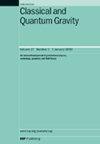Simulating binary black hole mergers using discontinuous Galerkin methods
IF 3.7
3区 物理与天体物理
Q2 ASTRONOMY & ASTROPHYSICS
引用次数: 0
Abstract
Binary black holes are the most abundant source of gravitational-wave observations. Gravitational-wave observatories in the next decade will require tremendous increases in the accuracy of numerical waveforms modeling binary black holes, compared to today’s state of the art. One approach to achieving the required accuracy is using spectral-type methods that scale to many processors. Using the SpECTRE numerical-relativity (NR) code, we present the first simulations of a binary black hole inspiral, merger, and ringdown using discontinuous Galerkin (DG) methods. The efficiency of DG methods allows us to evolve the binary through ∼ 18 orbits at reasonable computational cost. We then use SpECTRE’s Cauchy Characteristic Evolution (CCE) code to extract the gravitational waves at future null infinity. The open-source nature of SpECTRE means this is the first time a spectral-type method for simulating binary black hole evolutions is available to the entire NR community.用不连续伽辽金方法模拟双黑洞合并
双黑洞是引力波观测最丰富的来源。与目前的技术水平相比,未来十年的引力波天文台将需要在模拟双黑洞的数值波形的精度上有极大的提高。实现所需精度的一种方法是使用可扩展到许多处理器的光谱型方法。利用SpECTRE数字相对论(NR)代码,我们首次使用不连续伽辽金(DG)方法模拟了双黑洞的激励、合并和衰退。DG方法的效率使我们能够以合理的计算成本通过~ 18个轨道来演化双星。然后,我们使用SpECTRE的柯西特征演化(CCE)代码提取未来零无穷处的引力波。SpECTRE的开源特性意味着这是整个NR社区第一次使用光谱类型的方法来模拟双黑洞演化。
本文章由计算机程序翻译,如有差异,请以英文原文为准。
求助全文
约1分钟内获得全文
求助全文
来源期刊

Classical and Quantum Gravity
物理-天文与天体物理
CiteScore
7.00
自引率
8.60%
发文量
301
审稿时长
2-4 weeks
期刊介绍:
Classical and Quantum Gravity is an established journal for physicists, mathematicians and cosmologists in the fields of gravitation and the theory of spacetime. The journal is now the acknowledged world leader in classical relativity and all areas of quantum gravity.
 求助内容:
求助内容: 应助结果提醒方式:
应助结果提醒方式:


